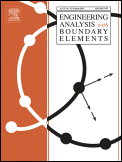Research Projects
Recent theoretical work in this area resulted in closed-form analytical expressions for the fundamental solutions of the coupled extensional-flexural behaviour of asymmetrically laminated plates.
Read more: The Boundary Element Method Applied to General Laminates
The project involves the development of different computational models and algorithms for the assessment of human exposure to Extremely Low Frequency (ELF) Electromagnetic fields. Accurate and efficient computational simulation allowed us to detect common situations in which the induced currents inside the body are well above current standards.
Read more: Human Body Exposure to ELF Electromagnetic Fields
In collaboration with the Russian Academy of Science
The main aim of this project is the development of analytical and numerical tools for the identification of stress fields in the earth's crust. This project will develop alternative theoretical foundations and algorithms to identify tectonic stresses, which involves formulation of mechanically consistent models based on the analysis of observations of stress orientations. Resulting data will contribute to the development of new approaches for the prediction of natural and man-induced hazards such as earthquakes, land slides, and tsunami initiation (including developments of early warning systems).
Read more: Development of direct approaches to tectonic stresses modelling
Preparing for the hydrogen economy by using the existing natural gas system as a catalyst
The main objective of NaturalHY is to prepare EU countries for the hydrogen economy by identifying and removing potential barriers regarding the introduction of hydrogen into society, using the extensive existing natural gas system. The basic concept of the project is the smooth and short term introduction of hydrogen, at relatively low cost, by using the existing natural gas system to carry and distribute mixtures of natural gas and hydrogen. The research focuses on investigating how hydrogen will affect the integrity and durability of pipelines in particular crack growth and corrosion.
Developing and integrating novel technologies to improve safety, transparency and quality assurance of the chilled/frozen food supply chain - test case fish and poultry (Chill-On)
Chill-On is a large scale intergrating project with 28 participating institutions from Europe, China and South America. Chill-On is part of the European Commission 6th Framework Programme - Food Quality and Safety.
The main goal of the CHILL-ON Integrated Project is the improvement of quality and safety information, transparency and traceability of the chilled/frozen supply food chain by developing cost effective technologies, devices and approaches for continuous monitoring and recording of the relevant data and processing the data for information management throughout the entire supply chain.
"Development of the stress trajectories element method (STEM)" supported by the EPSRC, UK
This project is aimed at the development of theory and numerical techniques for stress analysis in solids caused by applied forces or contacts with other solids. The key innovation of this proposal is the investigation of consistency between constitutive equations and stress trajectories. These cannot be given simultaneously and either of them could be used with equations of equilibrium to form a closed system of partial differential equations. We address three essentially different cases when stress trajectories are known (i) everywhere inside the domain; (ii) at discrete points inside the domain; (iii) on the boundary. In all these cases the stress trajectory concept is used as a unified approach; therefore the method proposed in this application is referred to as the stress trajectories element method, STEM.




